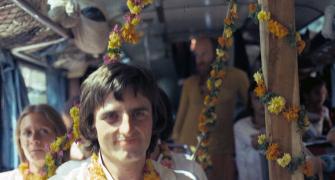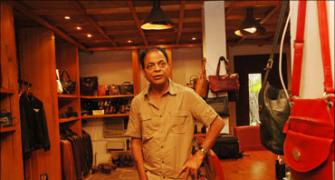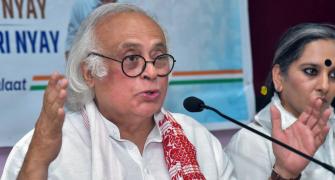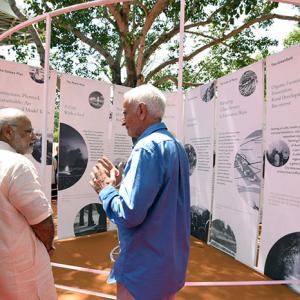Auroville just turned 50.
Aurovilians who grew up in the experimental city speak of how their childhood was marked by a sense of openness and possibility.
Nikita Puri reports from the City of Dawn.

IMAGE: Auroville's Matrimandir, with its geodisic dome, took 37 years to build and is covered with gold discs. Photograph: Kind courtesy DR/Wikimedia Commons
When Francis Neemberry, a Brooklyn-born American, wrote to his mother from India in the 1970s, he had a strange request: Could she send him 100 nail clippers?
'They are on their way,' she wrote back.
'But are you okay? And what are you going to do with 100 nail clippers?'
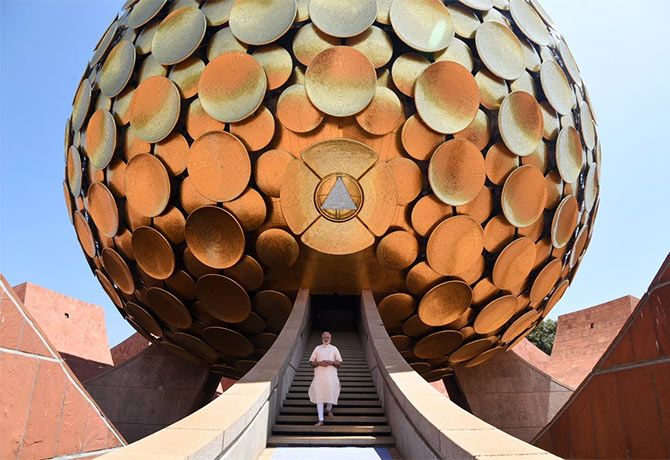
IMAGE: Prime Minister Narendra D Modi visits Auroville in its 50th year. Photograph: Kind courtesy @narendramodi_in/Twitter
The memory of this conversation jumps to Neemberry as he recounts the early days of the place he calls home -- Auroville.
 IMAGE: A model map of the City of Dawn. Most of Auroville is in Tamil Nadu, with some parts of it in the Union territory of Puducherry. Photograph: Kind courtesy IM3847/Wikimedia Commons
IMAGE: A model map of the City of Dawn. Most of Auroville is in Tamil Nadu, with some parts of it in the Union territory of Puducherry. Photograph: Kind courtesy IM3847/Wikimedia Commons
"India didn't have nail clippers back then and we were planting a gigantic forest," he says. "We had children from neighbouring areas come in to clip seeds. That's what the clippers were for. That was the time we were all eating ragi (finger millet), kambu (pearl millet), drinking eucalyptus tea and getting sunburnt."
As Neemberry, 78, recalls those days while sitting on the porch of his residence that has a high roof to combat the Indian summer, he is constantly interrupted by a few adamantly raucous peacocks that dwell in the forest-like areas around here.

IMAGE: Auroville is surrounded 3,930 acres of greenery. Photograph: Kind courtesy McKay Savage/Wikimedia Commons
The peacocks are a testament to how much Auroville has changed: In the 1960s, the place had become a barren plateau with a violent history of deforestation for housing and timber.
Today, it is easy to get lost among the many forest trails along which some 2,500 Aurovilians and wildlife flourish side by side.
After a half-hour drive from Puducherry (formerly Pondicherry), one begins to sense that Auroville is drawing closer.
The busy streets and city sounds begin to fade. Patches of green cover springing from red earth take over. (Most of Auroville is in Tamil Nadu, with some parts of it in the Union territory of Puducherry.)

IMAGE: Auroville's spiritual leader, The Mother, Paris-born Mirra Alfassa. Photograph: Kind courtesy Henri Cartier Bresson/Wikimedia Commons
In the 1960s, Auroville existed only as a dream of Mirra Alfassa, the Paris-born spiritual leader best known to the world as 'The Mother'.
A spiritual collaborator of Sri Aurobindo, Alfassa saw Auroville as a place unshackled by religion or politics, a place where people from all nationalities could collectively work towards a higher consciousness.
With recognition and endorsement from the Indian government as well as UNESCO, Auroville, the 'City of Dawn', has since survived, thrived and evolved.
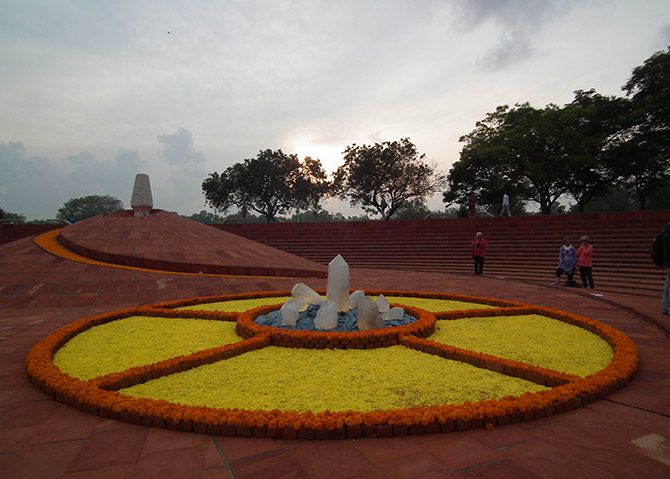
IMAGE: The commune's symbol done in flowers. Photograph: Kinfd courtesy Kazi Mir/Wikimedia Commons
On February 28, 1968, almost 5,000 people gathered together in a newly built The Mother read from the Auroville charter. Earth from 124 countries and 23 Indian states was poured into an urn that still stands.
Prime Minister Narendra D Modi was recently in Auroville to mark the 50th year of this episode. (While the city is apolitical, it has been supported, and even funded, by the Indian government since its establishment. Visits by politicians are rare, but not unheard of.)
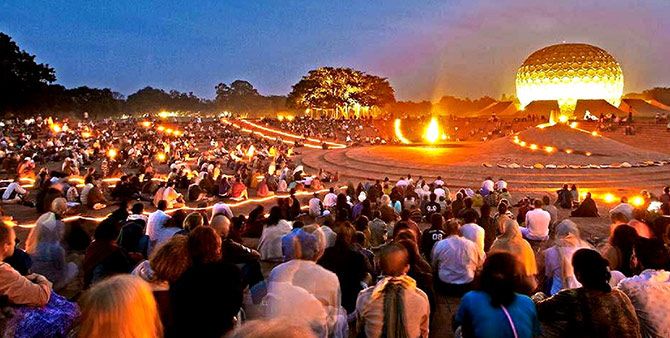
IMAGE: Auroville celebrates 50 years. Photograph: Kind courtesy Auroville.com
The Matrimandir is the most recognised symbol of Auroville.
This meditation hall can best be described as a giant, golden metallic sphere, akin to a tremendous golf ball.
On one side of this is the amphitheatre, on the other is the visitor's centre. The latter sees packed tourist buses pour in incessantly.
But the real Auroville is tucked away among the trees.
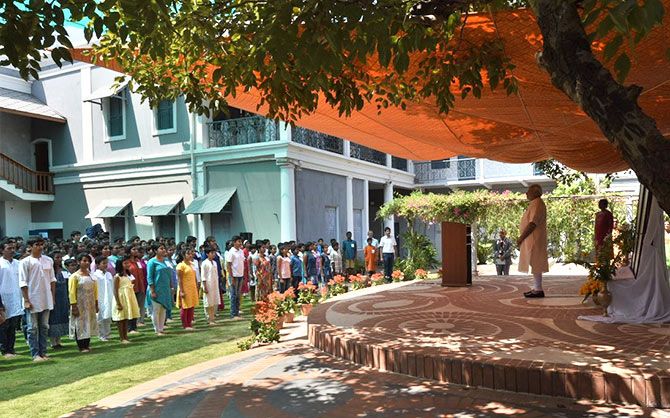
IMAGE: Prime Minister Modi at the Sri Auroville International Centre of Education. Photograph: Kind courtesy: @narendramodi_in/Twitter
Even as she laid down plans for Auroville, along with the French architect Roger Anger, The Mother understood that Auroville couldn't grow in isolation.
For instance, while some of the city's grain and vegetable needs are met by Auroville's farms, the rest comes from outside.
While Auroville is 'an attempt to achieve on earth a slightly more ideal life,' Alfassa was 'under no illusion that it will retain its purity, but we will try something.'
In 1967, The Mother said that one of the required conditions for living in Auroville was to be convinced about the unity of humankind, and work towards it.
There are guidelines for Aurovilians: Property, for instance, is a collective asset. No individual has ownership of any residence or commercial activity here.
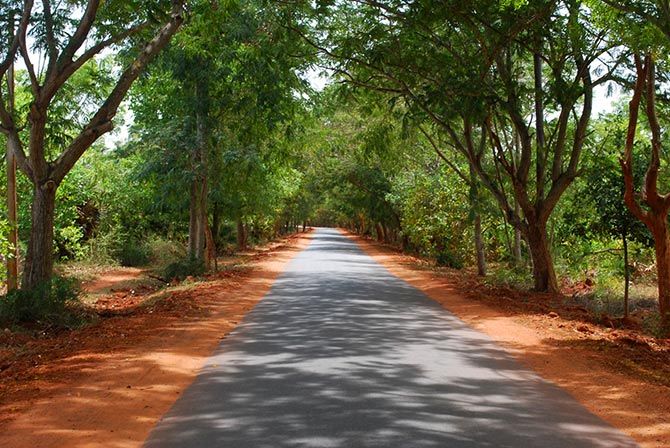
IMAGE: The real Auroville is tucked away among the trees. Photograph: Kind courtesy Sanyam Bahga/Wikimedia Commons
"Everyone is expected to work for Auroville in a vast variety of ways," says Anuradha Majumdar, a resident since 1979.
While some citizens work in the green belt of Auroville on forests and organic farmlands, Neemberry documents life in Auroville through films, and Klara Brogli, after a legal career in Switzerland, helps set up small businesses.
Farming, teaching, construction, art and cultural activities are some of the available roles in the city.
"Some may need to work outside to be able to contribute to Auroville. The more one is centred in the life and experience of Auroville, the more that two worlds can co-exist freely," says Majumdar, also the author of Auroville, A City for the Future.
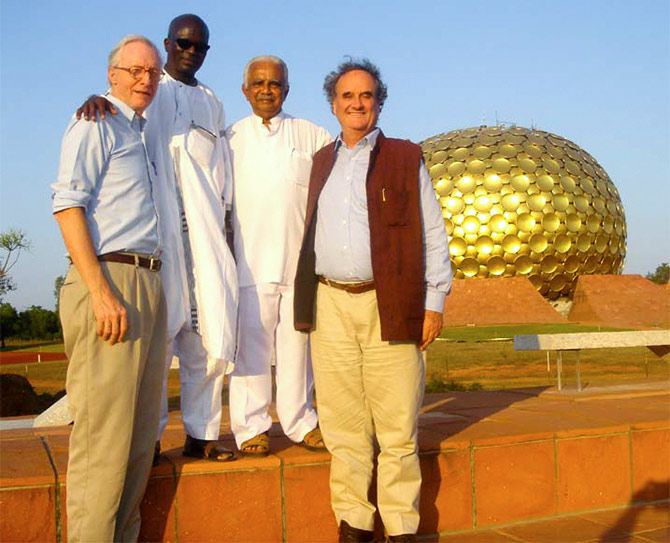
IMAGE: Journalist Mark Tully with other members of the Auroville Foundation's advisory committee. Photograph: Kind courtesy Sarvodaya Shramadana/Wikimedia Commons
With the Matrimandir at the centre of the township, Auroville is split up into zones in accordance with a sketch The Mother had drawn: The peace zone with the amphitheatre and a few gardens; the industrial zone that is home to Auroville's small- and medium-scale green industries; the residential zone, an international pavilion, and a zone of arts and education.
Surrounding Auroville on all sides is the green belt.
Auroville is spread across 3,930 acres. Residents include people from about 50 nations.
While the senior-most citizens are now in their 70s and 80s, people of all age groups make up Auroville, including a good population of school-going children.

IMAGE: After a half hour drive from Puducherry one begins to sense that Auroville is drawing closer.
The busy streets and city sounds begin to fade. Patches of green cover springing from red earth take over. Photograph: Kind courtesy IM3847/Wikimedia Commons
Its education system is equipped for children aged two to 19. At a time when the rest of the country is polarised by the subject of state and national languages, the children of Auroville speak at least three languages: French, Tamil and English.
Aurovilians who grew up in the experimental city all speak of how their childhood was marked by a sense of openness and possibility.
"As kids we really felt that we were part of a new world, literally and also conceptually," says Akash Kapur, author of Auroville: Dream and Reality.
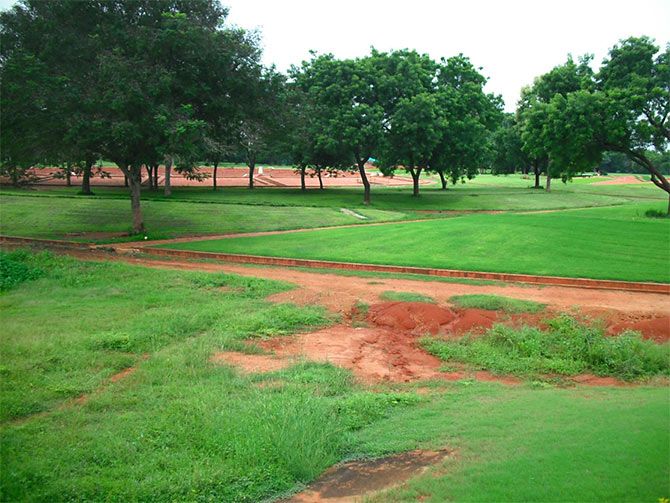
IMAGE: In the 1960s, the place had become a barren plateau with a violent history of deforestation for housing and timber.
Today, it is easy to get lost among the many forest trails along which some 2,500 Aurovilians and wildlife flourish side by side. Photograph: Kind courtesy Jaseem Hamza/Wikimedia Commons
But the journey to harmonious living hasn't always been smooth.
Frederick Schulze Buxloh, a German who first visited Sri Aurobindo's ashram in Puducherry in 1960, returned to the place in 1966, when there was talk about building a 'City of the Future'.
"Young people from all over the world had come together as volunteers to build Auroville as a city for everyone," he recalls.
The Mother didn't want Auroville to be put into an existing legal framework because it could then have taken any shape, says Buzloh.

IMAGE: The Mother saw Auroville as a place unshackled by religion or politics, a place where people from all nationalities could collectively work towards a higher consciousness. Photograph: Kind courtesy PPP/Wikimedia Commons
"After she left her body in 1973, the society, which up till then had looked after the legalities of Auroville, tried to own the property. The youth objected," says Buxloh.
The entity, the Sri Aurobindo Society (separate from the Aurobindo Ashram), called in the police to remove volunteers who they reportedly labelled 'trespassers on private property'.
Buxloh was among the ones who were jailed and beaten.
Then, industrialists such as J R D Tata and Indira Gandhi's government stepped in to protect Auroville.
Backed by the Supreme Court, the Auroville of today continues to grow.
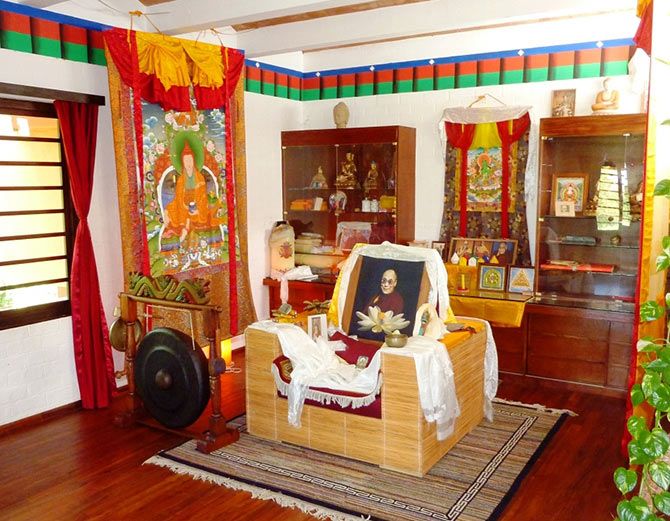
IMAGE: The Dalai Lama seat in the Pavilion of Tibetan Culture, Auroville. Photograph: Kind courtesy John Hill/Wikicommons Media
Old-timers all tell the same tale: Their first meeting with The Mother was a life-changing, purpose-giving experience. But one wonders if this call has been felt in equal measure by Auroville's newer blood, particularly those who came to Auroville after its founder passed away.
There is also the question of whether the city's Utopian ideals continue in their original state.
Communities such as Auroville, like humans, have a certain lifecycle, feels Kapur.
"We are past the stage of youthful, naive idealism. This is sad in some ways, because the idealism of teenagers is pure and beautiful," he says. The idealism of youth may perhaps not be the most effective way to get something done, he adds.

IMAGE: Aurovilians, like The Mother dreamed, come from all parts of the globe. Photograph: Kind courtesy @AuroSociety/Twitter
The current generation is maybe even cynical, but there is a healthy realism. I don't think anyone living here has altogether abandoned the original goals, otherwise why live here?" continues Kapur.
Auroville's idealism persists, sa"ys Majumdar, "but it is often overshadowed by more immediate needs and ground realities."
"I stay on because Auroville presents an infinite journey where the learning never stops. We still have a city to build which I am longing to see," she adds.
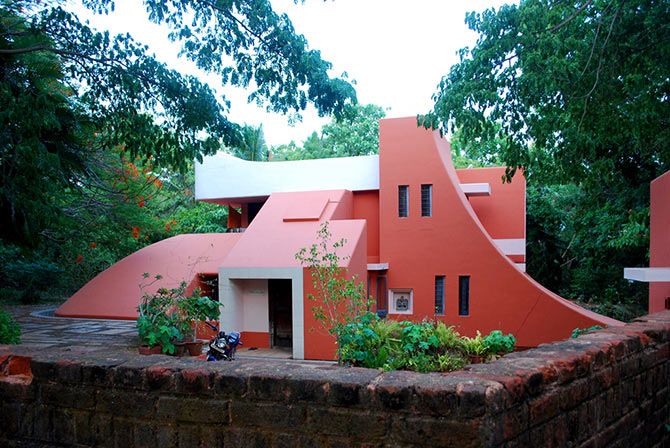
IMAGE: An Auroville house. Photograph: Kind courtesy Sanyam Bahga/Wikimedia Commons
A significant part of this culture is spiritual growth, the pursuit of a higher consciousness.
For instance, when one clashes with another in the world outside Auroville, it results in legal and police actions.
"None of that is acceptable in Auroville. You have to look at yourself and you hope the other guy is also doing the same," says Tim Wrey, a Briton who settled in Auroville in the 1970s.
A little away from Matrimandir, there is a steady flow of people exiting the eco-friendly solar kitchen post lunch.
One of Auroville's most popular eateries, this kitchen feeds an average of 1,500 to 2,000 people daily.
Directly above the kitchen is La Terrace, an open-air café. Wrey is here, sitting in crisp formals, in stark contrast to the people around him who move around in shorts or harem pants.
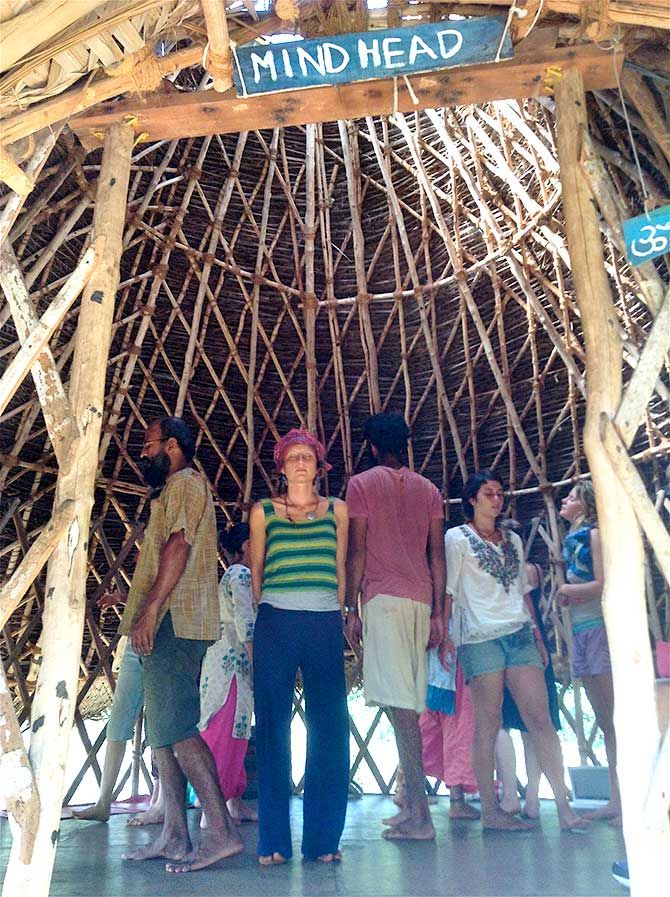
IMAGE: A theatre workshop in Sadhana Forest. Kind courtesy רפאל/Wikimedia Commons
When asked if he'd like a beverage, Wrey says, "I'll be the one getting you coffee. You can't use money here."
Wrey is referring to the fact that beyond the visitor's centre and a few eateries and shops, there is no circulation of cash inside Auroville.
The Mother had envisioned Auroville as a place where 'money would no longer be the sovereign lord'.
In an attempt to bypass the idea of cash, the city is responsible for providing its citizens' needs, partly in kind and cash, as much as possible.
"In turn, everyone makes a regular contribution to the common pot," says Majumdar.
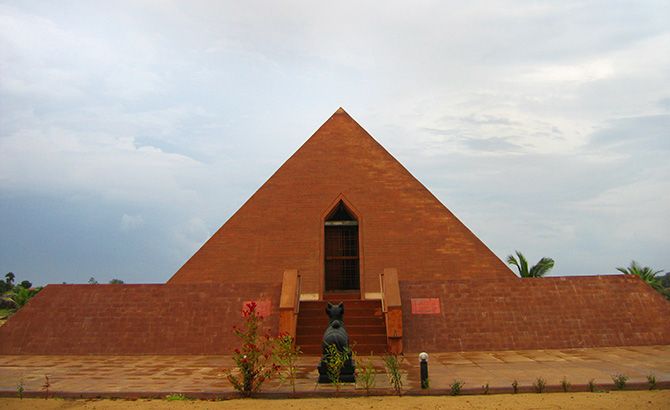
IMAGE: The Pyrmaid Natraja temple at Auroville. Photograph: Kind courtesy: Arunankapilan/Wikimedia Commons
Auroville's guests and volunteers depend on Aurocards, a kind of rechargeable debit card to minimise cash transactions.
And while cash comes in handy for refuelling bikes (Aurovilians don't use cars), lunches, health services and housing are either subsidised or covered for many.
One has to be a volunteer for at least one year before applying to be a 'citizen' of Auroville.
Wrey can often be found at the information desk at the visitor's centre, or conducting a visit to the Matrimandir for first-timers, or furthering Auroville's reality through printed works. This is a glimpse of the many roles an Aurovilian plays.
Wrey is also the author of Footsteps Through the Salad, a book on the wildlife and natural phenomena of Auroville.

IMAGE: A PCO at Auroville. Photograph: Kind courtesy Kanganarora/Wikimedia Commons
The name of the book comes from the time when Wrey was with an Aurovilian who tended to ill or rescued birds.
Over lunch, one of the birds in her care, a tiny owl, jumped into Wrey's salad and proceeded to walk through it before continuing across the table.
"With all the greenery it has, Auroville is actually like a giant salad. All the animals, reptiles and birds are just moving through it," he says.

IMAGE: Golden jubilee celebrations at Auroville. Photograph: Kind courtesy @VineelasriReddy/Twitter
From the many conservation and eco-friendly projects (harvesting water, wind and energy), external progress is easy to see in Auroville, feels Wrey.
More important is the inner progress that Aurovilians aspire for.
"The Mother was once asked how long will it be before you begin to see some realisation of human unity, the prime aim, in Auroville?" She replied that one may see the first signs (of it) in 300 years," he says.
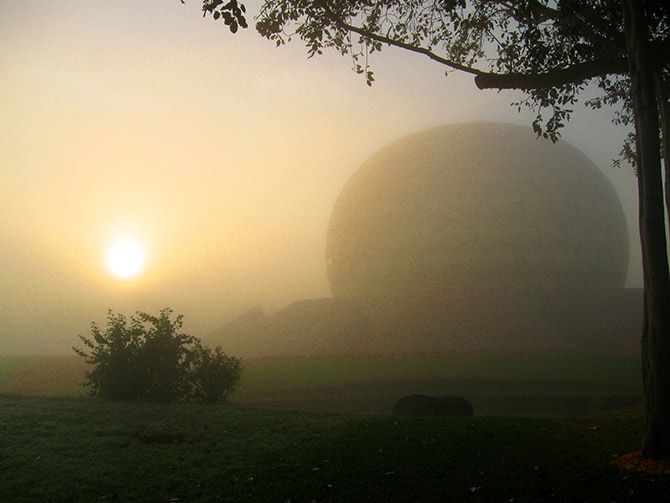
IMAGE: Dawn at Auroville. Photograph: Kind courtesy Arunankapilan/Wikimedia Commons
The observation that people from over 50 nations work alongside each other, without fighting, gives Wrey hope.
"The fact that 50 years on, this project still endures is why I believe Auroville will succeed and reach its goals, even if it is not in our lifetimes."



